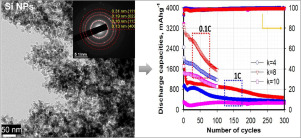Journal of Energy Storage ( IF 9.4 ) Pub Date : 2019-12-23 , DOI: 10.1016/j.est.2019.101141 Jong Hyeon Lee , Woo Seok Choi , Hwa-Young Woo , Hayk H. Nersisyan , En Mei Jin , Sang Mun Jeong

|
Silicone polymers, more accurately referred to as polysiloxanes (PSs), do not have carbon as part of the backbone structure and thus can serve as sustainable precursors for the fabrication of Si nanoparticles (Si NPs) for applications as anode materials for lithium ion batteries. First, PS is burnt in air and the combustion product is calcined at 800 °C to produce carbon free SiO2 nanoparticles (SiO2 NPs). Then SiO2 NPs are reduced by Mg under combustion regime, in the presence of NaCl. Si NPs between 5 and 100 nm is obtained by changing the concentration of NaCl. The Si NPs are tested as an anode material for Li-ion battery (LIB). The cycling performance and rate capability of LIB anodes are measured according to the size of the Si NPs. The results showed good cycling performance over 300 cycles with a low fading rate of 0.04% per cycle at 1 C and a high coulombic efficiency above 98%.
中文翻译:

锂离子电池用聚硅氧烷衍生的硅纳米颗粒
有机硅聚合物,更准确地称为聚硅氧烷(PSs),不具有碳作为骨架结构的一部分,因此可以用作制造Si纳米颗粒(Si NPs)的可持续前体,以用作锂离子电池的负极材料。首先,将PS在空气中燃烧,并将燃烧产物在800°C下煅烧,以生产不含碳的SiO 2纳米颗粒(SiO 2 NPs)。然后SiO 2在NaCl的存在下,燃烧状态下Mg可以使NPs还原。通过改变NaCl的浓度可以获得5至100 nm的Si NP。Si NP被测试为锂离子电池(LIB)的负极材料。LIB阳极的循环性能和倍率能力根据Si NP的尺寸进行测量。结果表明,在300个循环中具有良好的循环性能,在1 C下每个循环的衰落率为0.04%,并且库仑效率高于98%。



























 京公网安备 11010802027423号
京公网安备 11010802027423号